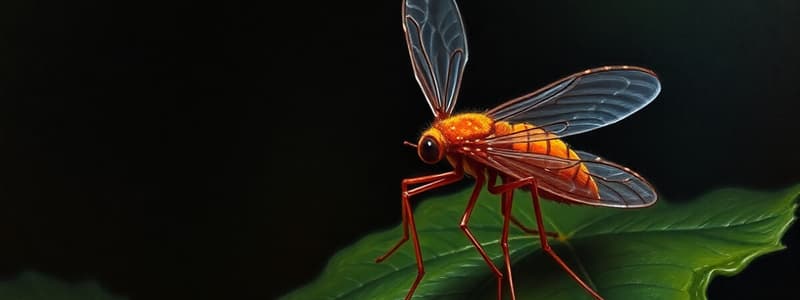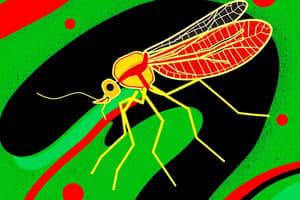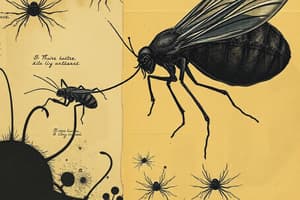Podcast
Questions and Answers
Which of the following statements is TRUE about the relationship between Plasmodium parasites and their hosts?
Which of the following statements is TRUE about the relationship between Plasmodium parasites and their hosts?
- Most Plasmodium species are specifically adapted to infect humans and cause malaria.
- All Plasmodium species infect humans and cause malaria.
- Plasmodium parasites infect various hosts, with humans being the most common and susceptible.
- Plasmodium parasites are a diverse group, with only a few species infecting humans and causing malaria. (correct)
- All Plasmodium species infect animals, with humans being accidental hosts.
Which of the following apicomplexan genera is associated with neurological pathology in humans?
Which of the following apicomplexan genera is associated with neurological pathology in humans?
- Babesia
- Isospora
- Toxoplasma (correct)
- Cyclospora
- Cryptosporidium
What is the primary function of the 'microtubule corset' in apicomplexan parasites?
What is the primary function of the 'microtubule corset' in apicomplexan parasites?
- Secretes enzymes essential for parasite survival in the host.
- Facilitates gliding motility and invasion of host cells.
- Encloses the apical third of the parasite, providing structural support and contributing to shape. (correct)
- Provides structural support for the parasite's outer membrane.
- Is responsible for DNA replication and genetic material.
Which of the following statements is TRUE about Plasmodium falciparum?
Which of the following statements is TRUE about Plasmodium falciparum?
Which of the following cellular structures is NOT found in apicomplexan parasites?
Which of the following cellular structures is NOT found in apicomplexan parasites?
What is the main mechanism by which Plasmodium parasites evade the host's immune system?
What is the main mechanism by which Plasmodium parasites evade the host's immune system?
How does chloroquine kill Plasmodium parasites?
How does chloroquine kill Plasmodium parasites?
Which of the following is NOT a known reason for the emergence of chloroquine resistance in Plasmodium?
Which of the following is NOT a known reason for the emergence of chloroquine resistance in Plasmodium?
How does sickle cell anemia provide some protection against malaria?
How does sickle cell anemia provide some protection against malaria?
Which of the following statements accurately describes the 'apical complex' found in apicomplexan parasites?
Which of the following statements accurately describes the 'apical complex' found in apicomplexan parasites?
What is the primary reason for the high mortality rate associated with Plasmodium falciparum infections?
What is the primary reason for the high mortality rate associated with Plasmodium falciparum infections?
Which of the following is NOT a common symptom of malaria?
Which of the following is NOT a common symptom of malaria?
How do Plasmodium parasites evade the immune system of their host?
How do Plasmodium parasites evade the immune system of their host?
What is the primary role of the 'microtubule corset' in apicomplexan parasites?
What is the primary role of the 'microtubule corset' in apicomplexan parasites?
Flashcards
Plasmodium species
Plasmodium species
Different types of protozoa that cause malaria.
Malaria pathology
Malaria pathology
The illness severity is linked to plasmodium's immune evasion tactics like sequestration.
Plasmodium lifecycle
Plasmodium lifecycle
A complex series of developmental stages that plasmodium undergoes in hosts.
Human host cells for Plasmodium
Human host cells for Plasmodium
Signup and view all the flashcards
Sickle cell anemia and malaria resistance
Sickle cell anemia and malaria resistance
Signup and view all the flashcards
Chloroquine
Chloroquine
Signup and view all the flashcards
Chloroquine resistance
Chloroquine resistance
Signup and view all the flashcards
Apicomplexa
Apicomplexa
Signup and view all the flashcards
Apicoplast
Apicoplast
Signup and view all the flashcards
Microtubule corset
Microtubule corset
Signup and view all the flashcards
Neglected Tropical Malaria
Neglected Tropical Malaria
Signup and view all the flashcards
Apicomplexan Genera
Apicomplexan Genera
Signup and view all the flashcards
Immune Evasion in Malaria
Immune Evasion in Malaria
Signup and view all the flashcards
Lifecycle Complexity of Plasmodium
Lifecycle Complexity of Plasmodium
Signup and view all the flashcards
Human Host Cell Colonization
Human Host Cell Colonization
Signup and view all the flashcards
Chloroquine Mechanism
Chloroquine Mechanism
Signup and view all the flashcards
Sickle Cell Trait
Sickle Cell Trait
Signup and view all the flashcards
Chloroquine Resistance Mechanisms
Chloroquine Resistance Mechanisms
Signup and view all the flashcards
Study Notes
Plasmodium and Malaria
- Malaria is caused by different species of Plasmodium.
- The pathology of malaria is linked to immune evasion by sequestration.
- The Plasmodium life cycle is complex, involving both humans and mosquitos.
- Plasmodium colonizes specific human host cells, primarily red blood cells.
- Sickle cell anemia can confer resistance to Plasmodium falciparum.
- Chloroquine kills parasites, but parasites have developed resistance, primarily through mutations in the PfCRT transporter.
Apicomplexans
- Apicomplexans are a group of eukaryotes.
- Six genera infect humans: Plasmodium, Cryptosporidium, Isospora, Cyclospora, Toxoplasma, and Babesia.
- Plasmodium causes malaria.
- Other genera cause diarrhea, neurological pathology, or rare zoonotic diseases.
Apicomplexan Cell Organelles and Structures
- Apicoplast, a metabolic organelle in most apicomplexans, is derived from a cyanobacteria endosymbiont.
- The inner membrane complex (IMC) and protein complexes ensure gliding motility and invasion, using a cytoskeleton composed of microtubule corsets and alveolin network.
- Actin is needed for gliding motility.
- Secretory organelles include micronemes (for motility) and rhoptries (for invasion), and dense granules (for invasion).
Malaria Epidemiology
- Plasmodium falciparum causes most malaria deaths globally (99.7% of African cases, 97% worldwide).
- Plasmodium vivax is usually uncomplicated, causing 75% of cases in the Americas and ~50% in Southeast Asia, with lesser cases caused by P. ovale and P. malariae.
Malaria Epidemiology
- 94% of malaria cases and deaths occur in Africa.
- Six countries account for over half of all malaria cases worldwide: Nigeria, Democratic Republic of Congo, Uganda, Côte d'Ivoire, Mozambique, and Niger.
Malaria Dynamics
- Cases of malaria have decreased substantially since 2010 due to improved control programs and access to medicine.
- There were ~228 million cases of malaria and ~405,000 deaths in 2018.
- Children under 5 accounted for 76% of these deaths.
- Results in roughly 93 million fewer cases and 590,000 fewer deaths each year.
Malaria Pathology
- Malaria is characterized by cyclical bouts of fever, timing linked to parasite division and release.
- Malaria can be uncomplicated or complicated (severe).
- Uncomplicated malaria involves fever, high parasitemia, and anemia.
- Complicated malaria involves severe anemia, cerebral malaria (coma, and death), and is primarily caused by P. falciparum.
Infected Cell Changes
- Infected red blood cells change shape, developing easily observable "knobs".
- These knobs contain Plasmodium falciparum erythrocyte protein 1 (PfEMP1), a critical factor in cytoadhesion and sequestration.
Cytoadhesion
- PfEMP1 on the infected erythrocyte knobs is 'sticky' and binds to multiple host receptors on the endothelium.
- This results in rosetting (infected erythrocytes clumping together, or sticking to non-infected erythrocytes and endothelial cells) leading to vascular occlusion and sequestration that hinders the spleen-dependent killing mechanisms.
Sequestration and Cerebral Malaria
- Severe malaria, typically caused by P. falciparum, results in sequestration of the parasite in the brain.
- Blocked capillaries, swelling, congestion, hemorrhage lead to coma and death, highlighting the critical role of sequestration.
Plasmodium Life Cycle
- Plasmodium transmission requires a mosquito vector (Anopheles spp.).
- The parasite has diverse infection stages in the mosquito and in humans.
- Sporozoites are inoculated into the skin by the mosquito, heading to lymph nodes and blood vessels, eventually reaching the liver.
Mosquito Feeding
- Mosquitoes feed directly from blood vessels, and their saliva contains chemicals to prevent clotting, facilitating transmission.
In Vivo Imaging
- Fluorescent Plasmodium sporozoites are visible as they pass through the mosquito proboscis and into the dermis, confirming direct observation.
Mosquito Injection of Parasites
- Sporozoites are injected into the skin.
- Different proportions of sporozoites are distributed to skin, lymph nodes, blood vessels, and to the liver.
Plasmodium Sporozoites Gliding in Vivo
- Once inside the skin, parasites move using gliding motility to find blood vessels.
- The sporozoites enter the blood system within 20 minutes to reach the human liver.
Liver Stage Invasion and Development
- Sporozoites reach the liver within 1 hour and infect hepatocytes, a major liver cell type.
- Sporozoites undergo multiplication through invasiveness to numerous liver cells.
- This asexual reproduction generates thousands of merozoites.
- The merozoites are then released to invade red blood cells (erythrocytes) to continue their life cycle.
Merozoites Replication
- Merozoites replicate inside red blood cells (erythrocytes).
- The parasite life cycle continues with a ring stage, and schizont stage, followed by the egress of merozoites for replication in new blood cells
Gametocytogenesis
- Merozoites are non-transmissible, so they differentiate into gametocytes to maintain the life cycle by transmission to a mosquito.
- Different gametocyte types (micro and macro) develop, and require specific conditions in the human.
- This process is important for maintaining the lifecycle.
Parasite Life Cycle in Human
- Sporozoites are inoculated into the dermis, enter bloodstream, then reach the liver to produce merozoites.
- Merozoites infect red blood cells (erythrocytes), which cause the disease through schizogony.
- Some merozoites differentiate into gametocytes, which are transmitted to mosquitoes.
Parasite Life Cycle in the Mammal
- A summary of the parasite life cycle in humans, emphasizing the major steps.
Into the Mosquito
- Gametocytes are taken up by a mosquito during feeding, developing into gametes in the midgut.
- The male and female gametes fuse to form diploid zygotes, which migrate to the basal lamina of the midgut.
Summary Lifecycle Stages
- A detailed summary of the lifecycle stages and diagrams provide visualization of each stage.
Malaria Resistance and Sickle Cell Anemia
- Sickle cell anemia is a genetic disease caused by a mutation in beta hemoglobin (HbS).
- Under low oxygen conditions, HbS polymerizes, causing red blood cells to sickle and become "sticky,".
- This condition correlates with regions affected by malaria, suggesting a balanced polymorphism.
The Malaria Hypothesis
- The prevalence of sickle cell allele (HbS) and malaria coincide, supporting a hypothesis for evolutionary selection.
- Carriers of one copy of HbS allele (HbAS) have an evolutionary advantage (resistance) against Plasmodium falciparum.
Malaria Protection Mechanisms
- Enhanced clearance of parasitized red blood cells, reduced parasite growth and invasion due to HbS characteristics, and changes in sequestration and rosette formation help explain resistance mechanisms for individuals with sickle cell anemia.
Balanced Polymorphism
- The sickle cell allele (HbS) is maintained in areas with high malaria because heterozygotes are protected against malaria, even though homozygotes have a reduced life expectancy.
- Other hemoglobin disorders like thalassemia show similar resistance benefits for individuals carrying one copy of the causative allele, underlining protective mechanisms against severe diseases.
Chloroquine
- Chloroquine is an antimalaria drug, originally used to treat malaria due to its ability to disrupt the parasite's metabolism by inhibiting heme breakdown to hemozoin.
- The mechanism of action involves chloroquine accumulation in the parasite's food vacuoles, leading to parasite death.
- Resistance to chloroquine has emerged through mutations in the PfCRT transporter, which affects the drug's accumulation in food vacuoles, impacting the efficiency of killing the parasite.
Mutations in PfCRT
- PfCRT, a transporter protein, regulates chloroquine accumulation within the food vacuole, directly impacting parasite survival and the efficacy of chloroquine.
- Mutations in PfCRT have been observed and enable parasite resistance to chloroquine.
Overall Summary
- Malaria is a severe parasitic infection caused by Plasmodium species transmitted through mosquito bites.
- The parasite's life cycle involves intricate stages in both humans and mosquitos, with complex biological interactions.
- Some genetic variations, such as sickle cell anemia, offer a balanced polymorphism, providing a degree of protection against malaria by reducing the parasite's growth and efficiency, while other conditions might offer similar protective benefits.
- Resistance to chloroquine has evolved due to mutations in PfCRT (Plasmodium falciparum chloroquine resistance transporter).
Studying That Suits You
Use AI to generate personalized quizzes and flashcards to suit your learning preferences.




